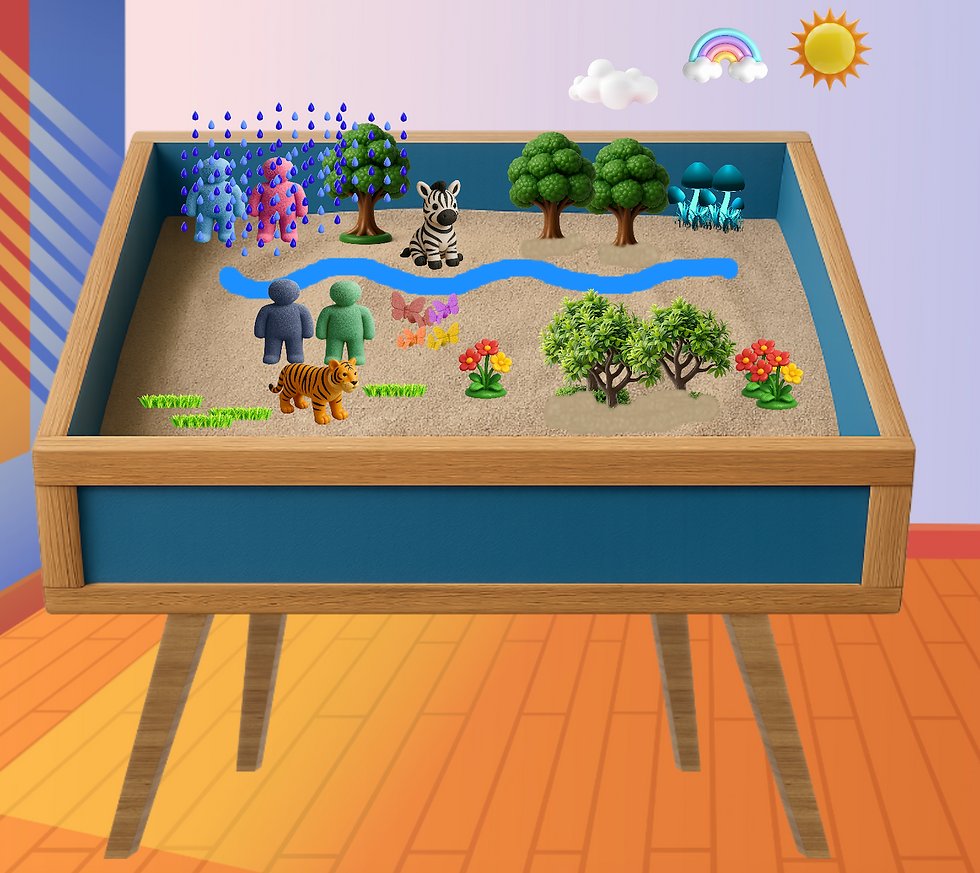5 Virtual Sand Tray Options and Ideas: For Telehealth and In-Person
- Jennie Lannette Bedsworth, MSW, LCSW

- 6 days ago
- 7 min read
Try these online sand tray platforms and ideas to engage your clients and expand your treatment options.
I hear sometimes that it’s not possible to effectively engage child and adolescent clients during telehealth. Some virtual therapists refuse to work with kids online because of it. But I’ve found that the right online therapy platforms can often enhance and improve therapy sessions.
Virtual sand tray is a great way to build a positive relationship while allowing your client to have power over their therapeutic process during an online session. There are many ways to try out or use an online sand tray for free, so let’s check them out!
If you’re unfamiliar with sand tray as a modality but find it intriguing, skip down to our background section for the scoop on sandplay and sand tray therapy. There are also a variety of sand tray trainings to get you started.
Virtual Sand Tray World by OnlineTherapyTools.com
This new virtual sand tray was built to “feel” like it’s in an in-person session. It can be used on any desktop browser like Chrome or Bing, and has a tablet/mobile version as well. (No apps required.)
This evidence-based online sand depicts a traditional setup. It has the same visual borders designed by the founders of sandtray, including blue walls and a sand floor. The miniatures have a 3D design so they seem more tactile. It still keeps the setup basic so it has less of a video game feel, while offering a couple of cool features you can’t find in physical form. For example, you can “pour” new sand or water over or under the miniatures.
Features of this online sand tray include:
More than 200 miniatures including Jungian archetypes, diverse characters, structures, animals, nature, vehicles, monsters, unicorns, dragons, religious symbols, hobbies, and more.
Natural placement of the miniatures: Clients drag the items off the shelf to place them in the sand, much like during an in-person session.
Sand and water features: You can “pour” sand if you want to bury miniatures or create rivers and lakes with the water tool. There’s even a rake!
Resizing: Here’s one trick you can’t do in your office–resizing your miniatures! You can make the same dragon teeny tiny or have it take up much of the space. It all depends on the emotional expression and needs of the client at that time.
Downloading an image: If your client can’t bear to leave their completed online sandtray behind they can download an image and take it with them. That can also be used as a therapeutic record and it’s a great way to continue your witnessing or discussion of the scene. Consider it as an option for TF-CBT narratives, if you’re doing other trauma work.
Secure and shareable on screen: There’s no need for your client to log in or give any information. You can simply share a link and they can access the tray and display it on their screen for you to view.
Straightforward features for enhanced connection: Clients can create “worlds” in all kinds of games these days, but the sand tray method was created with boundaries for a reason. The structure of the tray provides a safe space for the world to be expressed and naturally processed. Clients can lean in and engage rather than spacing out. This online sand tray offers a great way to encourage expression in a safe way.
Mobile or desktop versions: The desktop version offers the full features, but online therapists know that many clients (especially kids and teens) often use tablets or phones for sessions. So there is a more streamlined version that works well for mobile too.
Created by experienced therapist and designer: The virtual sand tray was created by the licensed therapist behind The Counseling Palette. She has decades of experience in therapy, social work, and creating interactive and educational therapy activities.
Check out the Sand Tray World here. I highly recommend at least taking a look!

Homemade Sand Tray Setups
Really wanting that tactile experience of the sand and miniatures during online sessions? There is another creative option I recommend in that case. Your clients can each create their own homemade sand tray at home with a few simple supplies. They can adjust their screen to show the tray (try propping up the tray on a stack of books) or show it to the camera periodically as they’re working on it. You can use all DIY supplies or supplement with tools like printable miniatures.
Here’s what they’ll need:
An old container like a baking dish or wide, shallow tupperware bowl.
Sand, or an alternative like salt or rice–whatever is easy and available
Small toys on hand like soldiers, dinosaurs, unicorns, etc.
Natural elements like rocks, small sticks, or shells
Paper, scissors, and crayons or markers
Tape
Optional: Printable miniature set
Clients fill their sand tray with table salt, rice, or even better, sand if they happen to have it. To create a miniature setup, have them collect their toys and put them in one box or other container, or spread them out on a table if they have room. They can also collect natural elements like twigs, flowers, or rocks.
Explain the idea of sand tray to your clients–that it’s a place to create imaginary worlds that are shown through characters, objects, and symbols. Have them think about ideas of miniatures they might want to include.
Depending on your modality and use of the tray, you might recommend they make certain archetype representations, or give them a list to choose from. You can assign this as homework or make it part of the therapeutic session.
To make the miniatures standable, cut a piece of 8.5x11 into 8ths (doesn’t need to be exact). Fold each strip of paper in half and then fold out little “feet,” to make them stand, like in the image example. Draw the miniature on each side, or the front of the miniature on one side and the back on the other.
If your client has access to a printer or you’re able to bring or send them printouts, check out this entire printable miniature set. It has a diverse set of people, symbols, and objects to choose from.
Now your client is all set up and ready to go! Work out with your client how to show their setup on screen. I recommend having them sit at a table and put their tray on top of a stack of books so the camera can catch it more easily.

Online Sand Tray by Karen Fried
My understanding is that Karen Fried unveiled her online sand tray during Covid as a way to support therapists and clients with limited sand tray options. She is an experienced play therapist and course instructor. The sand tray is often used in online trainings and has many of the familiar archetypes recommended for traditional sand tray and sand play work. You can simply share the link and you and your client are on your way. It’s definitely an option to have in your pocket!
Lego “Sand” Tray with Home Legos
A colleague recently showed me their Lego sand tray setup and I was blown away. What. A. Cool. Idea. The concept is similar, but instead of sand and miniatures you use a Lego base and Lego pieces and characters. Your clients can customize their own people, objects, and scenes. I am not an expert in this modality, but I’m sure it could be adapted for virtual play, similar to the home sand tray arrangement above. It can also be an option for your client to enhance their home tray, by making and using Lego characters.
Virtual Sand Tray App
I haven’t actually paid to check this one out myself but it looks interesting! It has a cool story. According to its website the Virtual Sand Tray App was developed after the Tohoku Tsunami in Japan so that a portable sand tray option would be available. After that it was made available virtually during Covid. It seems to have a very “archetype” feel and is also worth considering as an option for your virtual sessions.

History of Sand Tray and Sand Play
Now that you have some options for using sand tray in virtual sessions, you might want to know more about it, especially if you’re new to the modality!
(You can also learn more about using sand tray through our training partner PESI. Check out these courses.)
According to Linda Homeyer, who wrote an excellent summary of the history of sand therapy (source details below), the concept goes all the way back to the 1920s. Dr. Margaret Lowenfield observed the behaviors of children traumatized by war and noticed their resilience through play.
By setting up the sand tray and offering the miniatures, children seemed to naturally start creating worlds within the tray. Thus a concept called “World Technique” was born.
Later, Dora Kalff built on Lowenfield’s concepts and created a Yungian-based method called Sandplay. Sandplay is about witnessing the client’s creation of the world without the therapist’s interpretation. It is a specific therapy that can be offered by qualified and trained sandplay therapists.
Therapists also incorporate sand tray as a tool within treatments like EMDR, trauma-focused CBT, and therapy for clients who are neurodivergent. There’s also a popular Oaklander variation of sand tray widely used within the play therapy modality. Each has specific trainings and build upon existing modalities.
If you’re new to sand tray therapy I’d recommend exploring the variations available and finding one or more that fit within your therapeutic framework. Specific training will best prepare you to use in-person as well as virtual sand trays.
Ready to get started? Start with this online sand tray for free!
Source: Homeyer, L.E. (2025). The History of Sand Therapy. World Association of Sand Therapy Professionals.
About the Author
Jennie Lannette Bedsworth is a licensed therapist and the creator of The Counseling Palette, a trusted source for therapy games, group therapy activities, and printables. With two decades of experience in the mental health field, Jennie designs resources that make therapy engaging, effective, and accessible for all ages. Ready to transform your sessions? Explore our collection of therapy tools at The Counseling Palette.





Comments